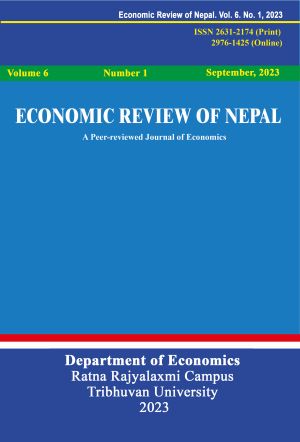Dynamics of Financial Development and Foreign Direct Investment on Nepal's Economic Growth: A NARDL Analysis
DOI:
https://doi.org/10.3126/ern.v6i1.67967Keywords:
financial development, economic growth, NARDL model, asymmetric effects, developing economies, foreign direct investmentAbstract
This study explores the asymmetric effects of financial development and foreign direct investment (FDI) on economic growth in Nepal, employing the nonlinear autoregressive distributed lag (NARDL) model. The analysis reveals significant asymmetries in the effects of FDI and financial broadening in the economy by distinguishing between positive and negative shocks, the outcome indicates that positive shocks in financial sector growth significantly boost the economy, while negative shocks have a less pronounced and statistically insignificant effect. Similarly, positive shocks in FDI positively influence GDP per capita growth, whereas negative shocks are statistically insignificant. The robustness of these findings shows stable model parameters. The study underscores the importance of proactive policy measures to harness the positive impacts of financial development and FDI, thereby fostering sustained economic growth in Nepal. These insights contribute to the broader literature by highlighting the need for asymmetric analysis in understanding the complex dynamics of financial development, FDI, and economic growth in developing economies.
Downloads
Downloads
Published
How to Cite
Issue
Section
License
Copyright (c) 2023 Department of Economics, Ratna Rajyalaxmi Campus

This work is licensed under a Creative Commons Attribution-NonCommercial 4.0 International License.
This license enables reusers to distribute, remix, adapt, and build upon the material in any medium or format for noncommercial purposes only, and only so long as attribution is given to the creator.




